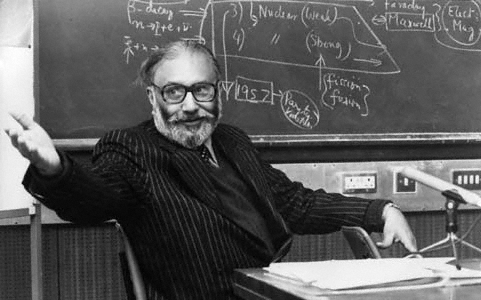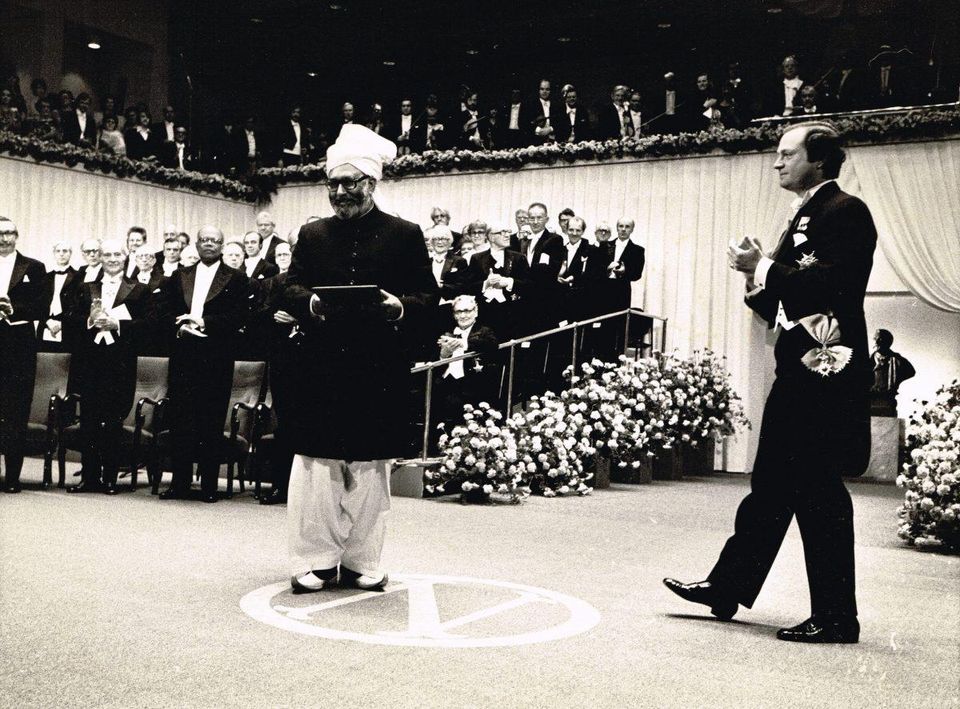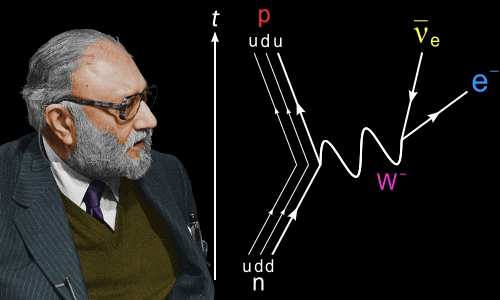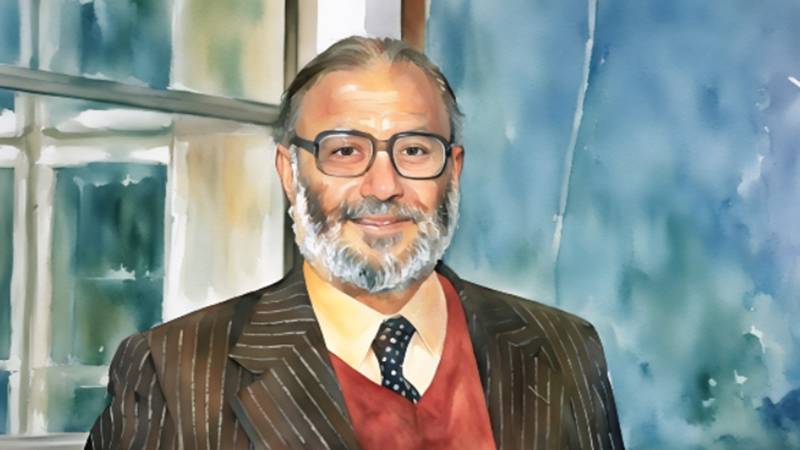Dr Abdus Salam was a Pakistani theoretical physicist, who In 1979, shared the Nobel Prize in Physics with US physicists Steven Weinberg and Sheldon Glashow for their groundbreaking research on the “electroweak unification theory.” Dr Salam is the first and only Pakistani scientist who has won the honorable Nobel prize in Physics.
Dr Salam was born in 1926, in the humble village of Jhang, Punjab, during the British Raj in India. He was a staunch believer in the movement of Pakistan, later identifying himself as a Pakistani. Salam was the youngest son and a favorite sibling. From early on, his grandfather had high hopes and ambitions for Salam in future endeavors. He was born to the Ahmedi family and remained an observant Ahmedi, applying his faith in all aspects of life, especially science.
From early on, Salam’s intelligence was visible; at 14, he earned the highest marks in the Matriculation Examinations ever recorded during his time at the University of Punjab. He was therefore offered a scholarship by Government College Lahore in 1940 when he was 16. Salam’s humble upbringing was such that upon entering Lahore, a larger, more urbanized city, he saw an electric lightbulb for the first time in his life.

Three years later In 1943, he published a scientific paper titled “A Problem of Ramanujan,” in which he solved a mathematical problem attempted by Ramanujan, who was considered a genius and prodigy in the realm of mathematics at that time, making this accomplishment quite a feat.
Soon his interest in Physics became evident, and he earned his Bachelor of Arts in Mathematics and Physics in two years, which was contrary to the standard three years. He then completed his Ph.D. in theoretical physics at Cambridge, receiving a scholarship to attend the university.
Nobel-Prize Winning Ideas
Dr Salam’s intelligence was never bound to his youth in academia but, rather flourished throughout his time as a theoretical physicist with the opportunity to research.
In 1956, Dr Abdus Salam discovered the revolutionary idea of “neutrino parity violation” through his independent research was rejected and even forced to wait for a longer publication. Unfortunately, due to this setback, two Chinese researchers published this idea and received credit.
Yet all was not lost for Dr Abdus Salam, who received the Nobel Prize for Physics shared with Steven Weinberg and Sheldon Glashow in 1979 “for their contribution to the theory of the unified weak and electromagnetic interaction between elementary particles, including…the prediction of the weak neutral current”. Though all of them shared the Nobel Prize, each independently researched this topic. Dr Abdus Salam conducted this research in the 1960s at the Imperial College of Science and Technology.
His Contribution to Physics
Dr Abdus Salam proposed the electroweak theory. In it, he sought to find the relationship between the electromagnetic force and the weak nuclear force. This was unheard of before since the electromagnetic force can extend over long distances, unlike the weak force, which only acts on ranges smaller than an atomic nucleus. Apart from this, the weak force was a reasonable discovery in Physics, confounding physicists worldwide.

What makes the weak force genuinely unique is how it does not conform to most rules of Physics. Like, weak force violates Parity Symmetry, also known as P Symmetry. Since it treats matter and antimatter differently, by acting on clockwise spinning matter particles and counter-clockwise spinning antimatter particles only. The weak force also violates Conjugating Symmetry and violates a combination of Parity symmetry and Conjugating symmetry known as CP symmetry. Another rule that weak force violates is the Time-reversal Symmetry, unlike all other forces such as gravity, electromagnetic force, and strong nuclear force.
This can be shown through the B0 Meson particles, which exist in two forms: B0 and B-0 (anti-B0). The structure of these particles can be altered over time by the weak force since it can switch particles from one form to another. In this scenario, it takes more time to change from B0 to B-0, then it does vice-versa, therefore, violating the time-reversal symmetry or T-Symmetry. T-symmetry states that both reactions should take an equal amount of time. This results in a weak force being dependent on the ‘direction of time’ and is currently the only known force to violate T-Symmetry as such.
All these examples go to show the ‘gravity’ of the situation that the existence of weak force creates (catch my pun?) since it threatens previous notions held in Physics. So, the concept of “weak force,” which defies most symmetry laws, is a genuinely mind-boggling conundrum for particle physicists all over the world, highlighting its importance and in turn, the importance of Dr. Abdus Salam’s discovery.
Dr Abdus Salam’s theory postulated that the relationship between the weak force and the electromagnetic force was connected through 4 “carrier” particles (which are massless), two of which are electrically charged and the rest are neutral. These messenger particles form a link and connect to the electromagnetic force. It is also postulated that an unseen field, known as the Higgs field aids this process.

Dr Abdus Salam’s research on the electroweak theory was later proven in an experiment in 1983 at CERN and is included in the Standard Model of Particle Physics, which is now considered the essential building block of physics. It is necessary for our fundamental understanding of Physics nowadays. Therefore, Dr Abdus Salam’s research was groundbreaking as it revolutionized the way we view physics and the world around us.
Role in the Pakistan Nuclear Program
Salam was so ambient on Pakistan’s desire for nuclear weapons to further strengthen its defense. He assured his support to the Pakistani Government for its nuclear program by 1974, right after his mind twisted, and he became a strong advocate of science for peaceful purposes.
In the same year, India successfully tested its first atomic bomb, the protests against Ahmadi (religious group) outnumbered, and due to its extremity, Pakitan’s Government constitutionally declared Ahmadi as non-muslim. Dr Salam had left with no choice but to resign from the post of science advisor to the Prime minister of Pakistan. Soon after, he left his homeland and settled abroad.
Dr Salam’s Legacy
However, Dr Abdus Salam’s legacy does not end with his death but keeps on with further research on his ideas. He was a charismatic, humble, and nice man with ethical values, but at the same time, he was different and challenging and inspired millions around the globe. Yet Dr Salam was never widely accepted in his country Pakistan due to religious differences, not a single university or monument in Pakistan carries his name.
Once in an interview, Dr Salam said that ” the present generation seems to inherit a house with very high walls and no windows; still they believe that it is a house, not a prison. They can never progress until and unless they try to rebuild this home on a strong and reliable basis.”
Also Read: The Rise of Machine; a dilemma of the digital age

Haniyah is an aspiring writer and science lover. She was raised in California and recently moved to Pakistan. She is currently studying her ‘O’ levels in Lahore. She is an avid fan of literature and loves to read. She is passionate about horseriding and spends her free time painting and horseriding. She is interested in robotics and has mentored a robotics team. Additionally, she has taken part in many robotics competitions, both international and local

